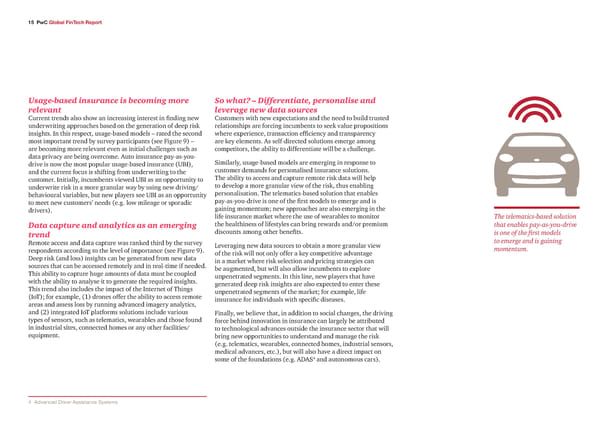1€ PwC Global FinTech Report Usage-based insurance is becoming more So what? – Differentiate, personalise and relevant leverage new data sources Current trends also show an increasing interest in finding new Customers with new expectations and the need to build trusted underwriting approaches based on the generation of deep risk relationships are forcing incumbents to seek value propositions insights. In this respect, usage-based models – rated the second where experience, transaction efficiency and transparency most important trend by survey participants (see Figure 9) – are key elements. As self-directed solutions emerge among are becoming more relevant even as initial challenges such as competitors, the ability to differentiate will be a challenge. data privacy are being overcome. Auto insurance pay-as-you- drive is now the most popular usage-based insurance (UBI), Similarly, usage-based models are emerging in response to and the current focus is shifting from underwriting to the customer demands for personalised insurance solutions. customer. Initially, incumbents viewed UBI as an opportunity to The ability to access and capture remote risk data will help underwrite risk in a more granular way by using new driving/ to develop a more granular view of the risk, thus enabling behavioural variables, but new players see UBI as an opportunity personalisation. The telematics-based solution that enables to meet new customers’ needs (e.g. low mileage or sporadic pay-as-you-drive is one of the first models to emerge and is drivers). gaining momentum; new approaches are also emerging in the life insurance market where the use of wearables to monitor The telematics-based solution Data capture and analytics as an emerging the healthiness of lifestyles can bring rewards and/or premium that enables pay-as-you-drive trend discounts among other benefits. is one of the first models Remote access and data capture was ranked third by the survey Leveraging new data sources to obtain a more granular view to emerge and is gaining respondents according to the level of importance (see Figure 9). of the risk will not only offer a key competitive advantage momentum. Deep risk (and loss) insights can be generated from new data in a market where risk selection and pricing strategies can sources that can be accessed remotely and in real-time if needed. be augmented, but will also allow incumbents to explore This ability to capture huge amounts of data must be coupled unpenetrated segments. In this line, new players that have with the ability to analyse it to generate the required insights. generated deep risk insights are also expected to enter these This trend also includes the impact of the Internet of Things unpenetrated segments of the market; for example, life (IoT); for example, (1) drones offer the ability to access remote insurance for individuals with specific diseases. areas and assess loss by running advanced imagery analytics, and (2) integrated IoT platforms solutions include various Finally, we believe that, in addition to social changes, the driving types of sensors, such as telematics, wearables and those found force behind innovation in insurance can largely be attributed in industrial sites, connected homes or any other facilities/ to technological advances outside the insurance sector that will equipment. bring new opportunities to understand and manage the risk (e.g. telematics, wearables, connected homes, industrial sensors, medical advances, etc.), but will also have a direct impact on 4 and autonomous cars). some of the foundations (e.g. ADAS 4 Ad€anced ri€er Assistance Systems
 Global FinTech Report Page 21 Page 23
Global FinTech Report Page 21 Page 23